#five dynasties and ten kingdoms period
Text
[Hanfu · 漢服]Chinese Five Dynasties & Ten Kingdoms Period(907-979) Traditional Clothing Hanfu Photoshoot
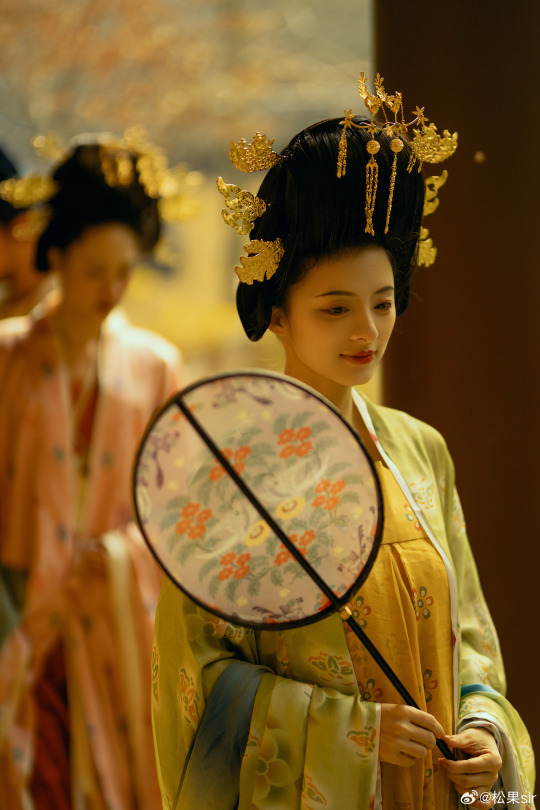
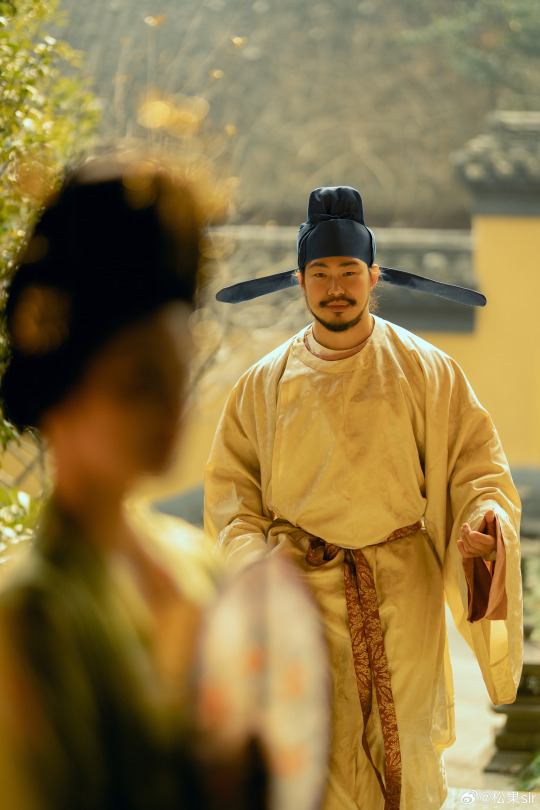
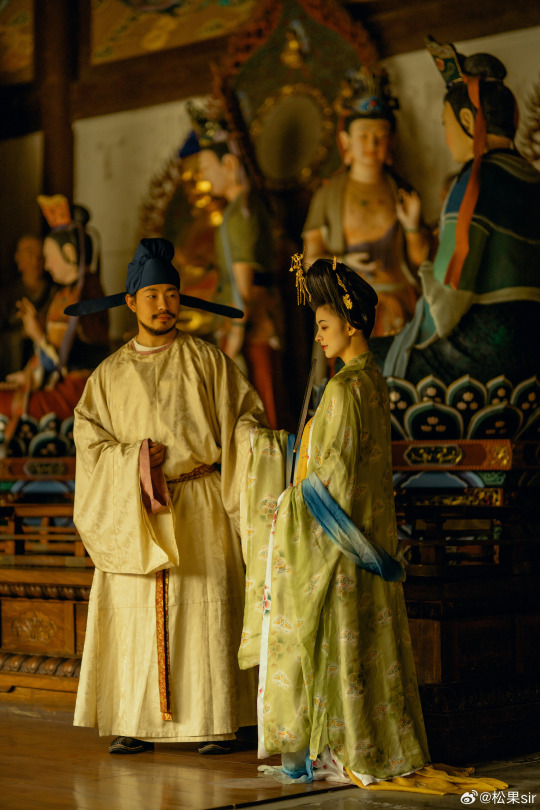
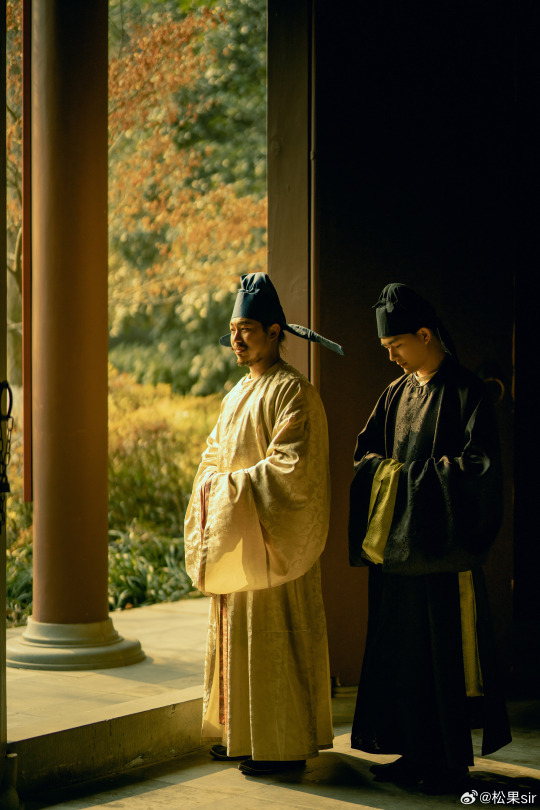



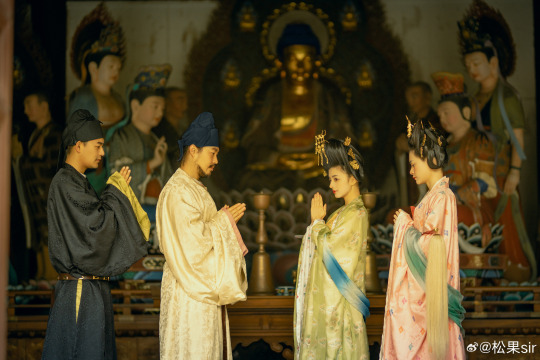




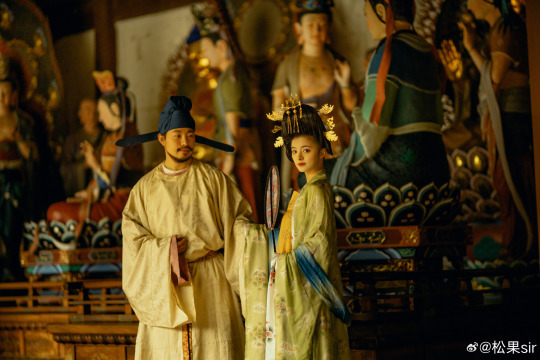





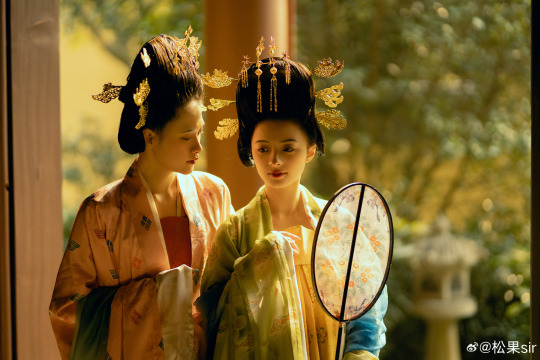


_______
🧚🏻🙋♂️ Model:@终南山下活死人墓祖师婆婆林朝英 @阿时Ashi_ @阿杬在吗“先生王騰”
Support staff:@鱼汤小哥哥 “王正义”
👗Hanfu: @鱼汤传统服饰 @桑纈 @宇宙尘兔
📸Photographer: 松果sir
Round Fan:@妃加
Fly-whisk:@槛外人武陆柒567
🔗Weibo:https://weibo.com/3250619702/NBvbcsivj
_______
#chinese hanfu#five dynasties and ten kingdoms period#hanfu#hanfu accessories#hanfu_challenge#chinese traditional clothing#china#chinese#hanfu photoshoot#hanfu girl#man hanfu#hanfu art#漢服#汉服#中華風#chinese style
225 notes
·
View notes
Text
like I get that in a game literally titled Three Kingdoms folks'd be disappointed about getting a DLC set in a completely different time period but honestly Eight Princes was probably the most perfect period they could've chosen for a chapter pack. plenty of factions, insane drama, very close in time to the Three Kingdoms period etc.
the DLCs fleshing out the Three Kingdoms period should've come out first yeah but like Eight Princes wasn't a bad move - there's only so far you can get into the Three Kingdoms period before there's basically only 3 factions there can be, and that just doesn't play off well the best parts of the game (diplomacy) y'know
#my rambles#if it were up to me there'd be a Spring and Autumn/Warring States pack but that period's stupid long probably substantial enough for-#-its own game with like 10 different DLCs providing diff timepoints to start at lol#tw3k#five dynasties and ten kingdoms period could also make for a fun game. northern/southern dynasties too maybe
0 notes
Text
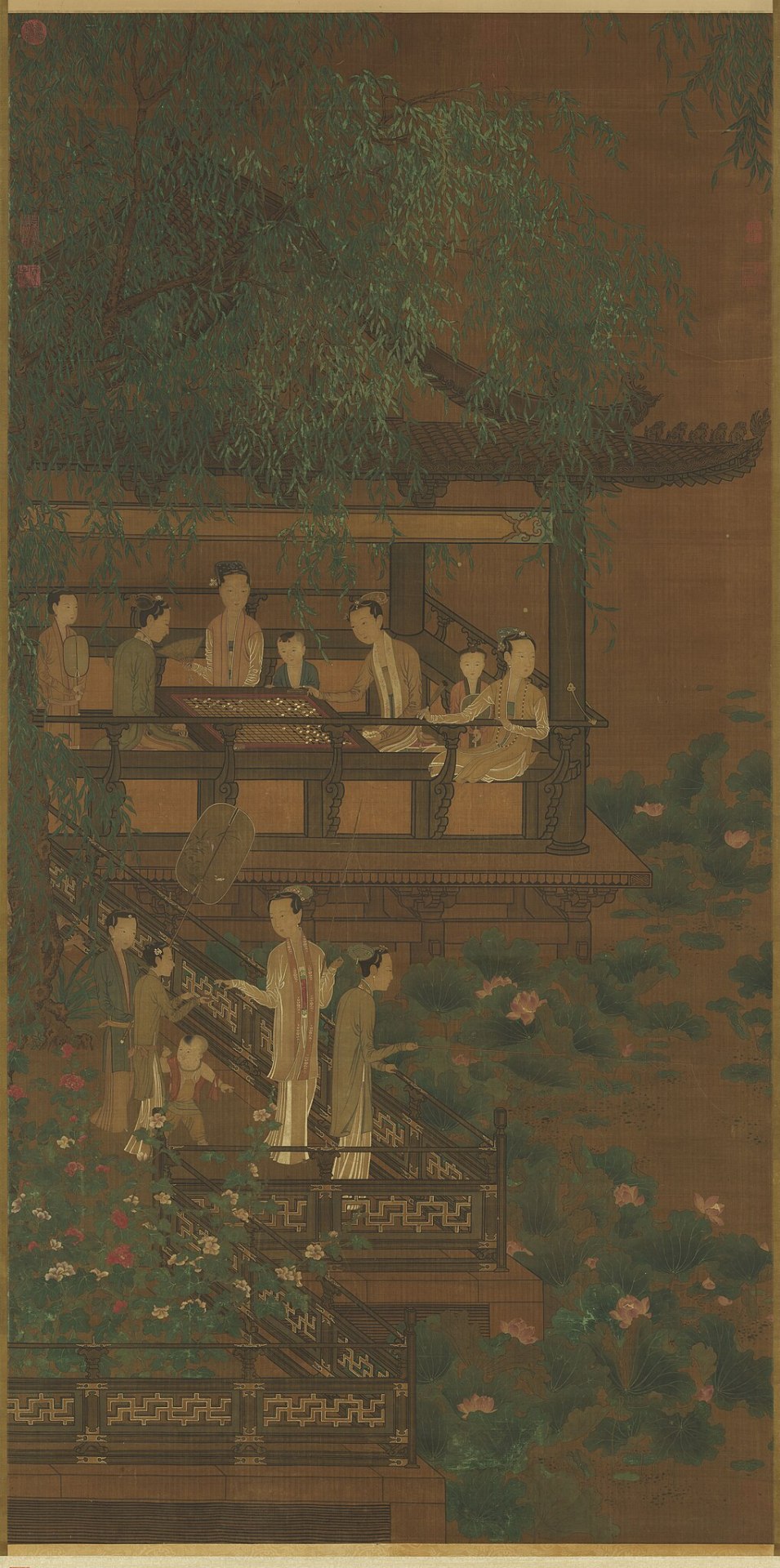

Ladies fishing by a lotus pavillion by Zhou Wenju (917-975) Five Dynasties and Ten Kingdoms Period China
25 notes
·
View notes
Text
Chuang argues that untill the nineteenth century there was essentially no such thing as China, the word didn't exist and neither did the concept. For example:
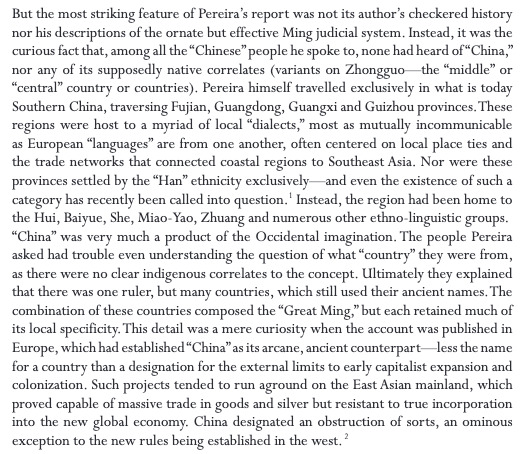
It seemed really hard to believe to me, that there was no concept for this huge state which had existed for nearly two thousand year in roughly the same location, and which, though it often changed dynasties or split apart, always ended up reforming.
But looking at the timeline of imperial China, the periods of division are much longer than I thought, the "ephemeral" divided states often lasted generations or centuries, and some Chinese dynasties only ruled the entirety of "China proper" for a very brief period of time.
The period considered "golden ages" are almost the same as the period of lasting rule of the whole of "China proper" by a native Chinese dynasty. That means the latter is quite rare.
Starting in 221 BCE we have the founding of the Qin Empire, which lasts only fourteen years, after five years of division comes the Han Empire, which except for a brief interuption by the Xin Dynasty rules continuously untill 22O CE.
Then we have the Three Kingdoms period which ends with the Jin unification in 280 CE. But though the Jin Dynasty would last longer, they only ruled the whole of China for a pathetic 24 years. Then there's the Sixteen Kingdoms period, followed by the Northern and Southern Dynasties period.
In 581 CE there's the founding of the Sui dynasty, which is replaced by the Tang Dynasty after only 37 years. The Tang would last 289 years.
In 907 CE the Five dynasties and Ten Kingdoms period begins. In 979 the Song dynasty is founded. I wasn't sure if the Northern Song should be counted as a united China. They ruled most of it, but there were still two other dynasties, the Western Xia and Liao. Ultimately I decided it didn't count because Xia and Liao, althought founded by non-chinese, seem to have been "Chinese-style" empires and controlled some territories in China proper (including Beijing!). By the Southern Song, The Liao had been replaced by the Jin (unrelated to the previous Jin dynasty) and the Song had lost contol of even more "core Chinese" territory. Then the Mongols show up, and do their usual thing.
This leads to the creation of the Yuan dynasty in 1279, which only rules for 89 years before beeing replaced by the Ming in 1368, which are then conquered by the Qing Dynasty in 1644, which rules China until 1912.
I think you can roughly periodize the imperial era as such:
There's the "Old Empire" from 221BCE to 220 CE, which is mostly just the Han dynasty. That's 441 years.
A "First Intermediate Period" of almost continuous division (the cringe Jin basically don't count) from 220 CE to the Sui unification of 581. That's an enormous 361 years.
A "Middle Empire"frome 581 to 907 (326 years total), which is mostly just the Tang dynasty.
A "Second Intermediate Period" from 907 to 1279 (372 years!) where again there is aways several states in China proper.
The "New Empire" from 1279 to 1912 (633 years), which lasts much longer than the other twos, but more than half of the time it is under a foreign dynasty.
(I am well aware of how presumptuous it is to make up my own periodization of Chinese history based off glancing at Wikipedia)
Overall, from 221 BCE to 1912 CE, (2133 years):
China is united under a "native" dynasty for only 1062 years (50% of the time).
It is united under a "foreign" dynasty for 357 years (17% of the time)
It is several states for 714 years (33% of the time).
There were only three "native" dynasties which ruled the whole of China for a non-trivial amount of time (Han, Tang and Ming), and one "foreign" dynasty (the Qing).
So I guess it's plausible than people would not have conceived of "mainland East Asia (as Chuang calls it) as one country which is periodically divided, but instead several countries which are occasionnally united.
7 notes
·
View notes
Text
The Meaning of Huanyue 浣月 / Cleansing Moon
On a superficial level, Huanyue 浣月 can be broken down to Cleansing Moon. Which is not entirely wrong. But hmm, has anyone ever told y’all that there is a famous painting named the, 「Huanyue Picture 浣月图」?
But before I start, I’m going to put a giant disclaimer that this is the only thing that I can find that’s even remotely related to Huanyue. I can’t find a poem with both characters in the same line lol. So I guess this picture was the inspiration behind Huanyue? And well, if it isn’t then I guess we’ll all learn about the existence of this picture either way. 🙃

So this picture is drawn by an anonymous painter in the Five Dynasty/Ten Kingdoms period and if you ever want to view it, it’s in the National Palace Museum in Taipei.
The bright moon hangs high in the painting. There are various plants in the courtyard - branches, wutong, banana leaves, hibiscus and daisies. A dragon lays coiled on the stone, a woman holding a pearl bends over the basin, trying to wash the pearl. There are three attendants whom appear serious whilst holding something; some think it could be incense for prayers. It’s common for women to pray to the moon since the Tang Dynasty, so it’s guessed that this picture was probably depicting moon worship.
So yes, this likely was the inspiration between 浣月 Huanyue. It has some connotations to moon worship. But lol, I’m not sure what inspired MXS to use this as a reference. Again lol, there is a lot of “feminine” symbolism in this novel. 😂 (Though I have no idea why at this moment of time). I’ll be updating this meta if I find new more information, but that’s it for now!
30 notes
·
View notes
Text
浪淘沙令·帘外雨潺潺 - Waves Washing the Sand (Ditty) · The Sound of Rain Beyond the Windows
by 李煜 (Li Yu, 937 - 978)
帘外雨潺潺 春意阑珊
lián wài yǔ chánchán, chūn yì lánshān
Beyond the blinds, strumming rain; Spring’s presence fades.
罗衾不耐五更寒
luóqīn bù nài wǔgēng hán
Quilts of silk are no match for the chill of the Fifth Watch.
梦里不知身是客 一晌贪欢
mèng lǐ bù zhī shēn shì kè, yī shǎng tān huān
Within the dream, a guest yet unaware, indulged in a moment of joy.
独自莫凭栏 无限江山
dúzì mò pínglán, wúxiàn jiāngshān.
When alone, don’t lean on the railings; the landscape of the country extends, infinite.
别时容易见时难
bié shí róngyì jiàn shí nán.
Parting was easy then, meeting again is hard.
流水落花春去也 天上人间
liúshuǐ luòhuā chūn qù yě, tiānshàng rénjiān.
Waters flow, flowers fall, Spring has gone. In Heaven or the mortal world?
………………………………………………………………………………………….
Notes
I think the most borrowed line in this very famous poem is 别时容易见时难 // the parting was easy, to reunite hard. It was also this line that led me here, though I’ve forgotten which novel was responsible. And even though it is my favourite line, I was quite stuck trying to English 梦里不知身是客 + 天上人间 and set this aside xD Yesterday, @liberty-or-death reminded me of it, so I dusted it off and lo! was struck by inspiration. And here we are!
I love dreaming and I love all my dreams, even the sometimes frightening ones. And hearing what dreams and dreaming is like for others through songs and poetry brings me so much delight. Maybe I should make a tag for this theme.
Background
Li Yu was the last ruler of Southern Tang during the Five Dynasties and Ten Kingdoms. We read his last ever poem 《虞美人·春花秋月何时了》 (Lady Yu · Spring flowers, Autumn moon, oh when will they end?) which was written before his death in 978 CE. This one was from around the same period of his life, during the three years of imprisonment by Tang Taizong according to 《苕溪渔隐丛话》 Assembled Remarks by the Fisherman Recluse of Tiao Creek, volume 59, under《西清诗话》.
Keeping this background in mind, let’s go to the translation :D
Translation
A 帘 (lián) is like a blind with bamboo slats as seen in the painting below from the Southern Song Dynasty attributed to Li Tang (1070 - 1150).
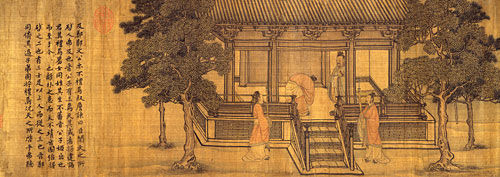
(Source)

Here’s an example from a modern picture.
(Source)
The word 潺潺 (chánchán) is an onomatopoeia for running water or splashing according to baidu, and in this case it was supposed to be the sound of falling rain, which didn’t make much sense to me because the word in Mandarin doesn’t sound like anything water makes. So I went to search it up on wikipedia for pronunciations in dialects or old chinese, and got saan4 in cantonese and sɡreːn in old chinese, which was more satisfying. Made a vague gesture in that direction with ‘strumming’ for fun. If I wanted to be a little more accurate, it’d probably be murmur?
Traditional timekeeping at night was announced via a drum or gong sounded by the drum tower in city centers, and by night watchmen hitting a gong in the streets (at least, if cdramas are to be believed xD). Each time point was called a 更 (gēng, watch) and refers to the rotation of watchmen sounding those signals. There were five watches, numbered one to five, each 2.4 hours long. For more detailed information, you can check out the wiki page. (If there’s one thing I love about the passage of time, it’s the increasingly detailed information shared in English that means I no longer have to look things up and explain them thoroughly heehee). The Fifth Watch is the last 2.4 h before sunrise, extending from 4am to 6 or 7am, which also happens to be the coldest part of the day.
My favourite line is this one:
梦里 | 不知 | 身是客 / 一晌 | 贪欢
Within the dream | not knowing | the self is a guest / in the moment | joyful
It might not be meant read this way, but I like to understand the 贪 (greed) in 贪欢 as that in 贪玩 (playful), an indulgence in joy. It’s a very relatable line.
I sort of read 独自 | 莫凭栏 无限江山 as ‘alone, don’t go to the railings (expecting) to see rivers and mountains (the kingdom) infinitely stretching out before’. By the way, here’s an interesting article on types of railings and their designs - it is, unfortunately, in Chinese only… but there are pictures! Li Yu says, don’t lean on the railings, don’t look out. Maybe he is telling himself because there is no kingdom and no beauty of that 无限江山 out there for him. Tells us what he was dreaming of without actually saying anything.
For 别时容易 (parting was easy), this was referring to his lands and all that was precious to him. This sentiment is another relatable one, and has been expressed in various other words, like Cao Pi’s (187 to 226 BCE)《燕歌行》Sparrow Song, 别日何易会日难 // how easy the day of parting, is the difficulty of meeting. Difficult to truly empathize until it happens to you.
My impression of 流水落花, more than unrequited love and defeat, is the physical reminder of the passage of time and the loss that is a natural part of it. Youth has passed like the beautiful season of lively Spring. Flowers fall and wither just as we are on our way to our ends, and relentlessly the river of time flows on. When I think about this, I often feel a bit disconnected. Or when coming out of very fun dream and the realization of reality and all the problems that come with it rushes back in. They existed when I was in ‘heaven’ and back ‘on earth’ too.
36 notes
·
View notes
Text

Silk banner depicting the temptation of The Buddha by the demon Mara and his army of demons. The banner is notable for being the first known depiction of a firearm, with one of the demons brandishing a fire lance. China, Five Dynasties and Ten Kingdoms period, c. 950 CE.
[Guillaume Gris]
* * * *
"As we approach the longest day of light at the summer solstice we are also moving from the Wood element of spring into the element of Fire in TCM, Traditional Chinese Medicine. The Fire element is our consciousness, our passion, our joy, our enthusiasm for this life journey. It is also our heart and our capacity to care for our heart. In TCM our heart is the supreme Monarch or the Emperor. Essentially all the other 11 meridians are in service to the heart because if the heart stops, life as we know it stops. The Heart's Yang partner in the Fire element, Small Intestine, acts like the alchemist to separate the pure from the impure. It grants us the gift of discernment to know, and to have the capacity to choose, what is nourishing and life supporting for ourselves in every moment.
The Fire element also rules our relationships and grants us the capacity to love and to be loved."
~ Sabina Pettit
[Ian Sanders]
#TCM#The Fire Element#silk banner#The buddha#Mara#The army of demons#mericians#Teraditional Chinese Medicine#the heart#Sabina Pettit#ian sanders#Guillaume Gris
15 notes
·
View notes
Photo

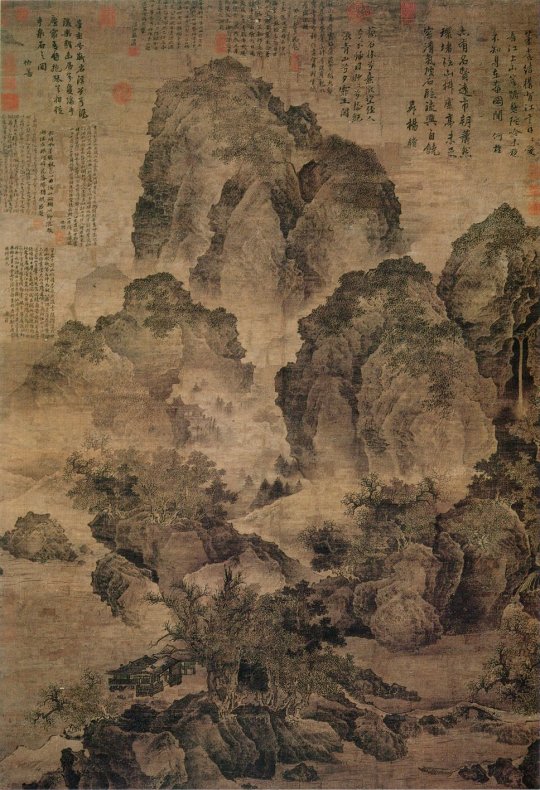
Jing Hao (c. 855—915), Mount Lu, Five Dynasties and Ten Kingdoms period (907-979 C.E.), hanging scroll, ink on silk, National Palace Museum, Taipei.
Fan Kuan (10th—early 11th century), Sitting Alone by a Stream, Song dynasty (960-1279 C.E.), National Palace Museum, Taipei.
49 notes
·
View notes
Photo

Song Dynasty Chinese Drama 《A Dream of Splendor 梦华录》 🎀 𝙼𝚊𝚒𝚍𝚎𝚗 𝚏𝚛𝚘𝚖 𝚝𝚑𝚎 𝙲𝚑𝚒𝚗𝚎𝚜𝚎 𝙵𝚒𝚟𝚎 𝙳𝚢𝚗𝚊𝚜𝚝𝚒𝚎𝚜 𝚙𝚎𝚛𝚒𝚘𝚍 𝚠𝚒𝚝𝚑 𝚛𝚎𝚍 𝚑𝚊𝚒𝚛 𝚛𝚒𝚋𝚋𝚘𝚗𝚜 🎀 𝚁𝚎𝚍 𝚑𝚊𝚒𝚛 𝚛𝚒𝚋𝚋𝚘𝚗𝚜 𝚠𝚎𝚛𝚎 𝚊 𝚌𝚘𝚖𝚖𝚘𝚗 𝚑𝚊𝚒𝚛 𝚊𝚌𝚌𝚎𝚜𝚜𝚘𝚛𝚢 𝚊𝚖𝚘𝚗𝚐 𝚢𝚘𝚞𝚗𝚐 𝚠𝚘𝚖𝚊𝚗 𝚍𝚞𝚛𝚒𝚗𝚐 𝚝𝚑𝚎 𝚂𝚘𝚗𝚐 𝙳𝚢𝚗𝚊𝚜𝚝𝚢. 𝚃𝚑𝚎 𝙲𝚑𝚒𝚗𝚎𝚜𝚎 𝙵𝚒𝚟𝚎 𝙳𝚢𝚗𝚊𝚜𝚝𝚒𝚎𝚜 𝚊𝚗𝚍 𝚃𝚎𝚗 𝙺𝚒𝚗𝚐𝚍𝚘𝚖𝚜 𝚙𝚎𝚛𝚒𝚘𝚍 (𝟿𝟶𝟽 𝚝𝚘 𝟿𝟽𝟿) 𝚖𝚘𝚜𝚝𝚕𝚢 𝚛𝚎𝚏𝚎𝚛𝚜 𝚝𝚘 𝚝𝚑𝚎 𝚎𝚛𝚊 𝚊𝚏𝚝𝚎𝚛 𝚝𝚑𝚎 𝙵𝚊𝚕𝚕 𝚘𝚏 𝚃𝚊𝚗𝚐 𝙳𝚢𝚗𝚊𝚜𝚝𝚢 (𝟿𝟶𝟽) 𝚝𝚒𝚕𝚕 𝚝𝚑𝚎 𝚎𝚗𝚍 𝚘𝚏 𝚝𝚑𝚎 𝚂𝚘𝚗𝚐 𝙳𝚢𝚗𝚊𝚜𝚝𝚢 (𝟿𝟼𝟶) 𝚝𝚑𝚞𝚜 𝚝𝚑𝚎 𝚌𝚕𝚘𝚝𝚑𝚒𝚗𝚐 𝚒𝚜 𝚕𝚊𝚛𝚐𝚎𝚕𝚢 𝚕𝚒𝚔𝚎 𝚂𝚘𝚗𝚐 𝙳𝚢𝚗𝚊𝚜𝚝𝚢 𝚠𝚒𝚝𝚑 𝚛𝚎𝚖𝚗𝚊𝚗𝚝𝚜 𝚏𝚛𝚘𝚖 𝚝𝚑𝚎 𝚃𝚊𝚗𝚐 𝙳𝚢𝚗𝚊𝚜𝚝𝚢. ______________________________ ⚠️ 𝗥𝗘𝗙𝗘𝗥𝗘𝗡𝗖𝗘 (𝗿𝗲𝗹𝗶𝗰 𝗶𝘀 𝗼𝗻𝗹𝘆 𝘂𝘀𝗲𝗱 𝗮𝘀 𝗰𝗹𝗼𝘁𝗵𝗶𝗻𝗴 𝗰𝗼𝗺𝗽𝗮𝗿𝗶𝘀𝗼𝗻 𝗻𝗼𝘁 𝗶𝗺𝗽𝗹𝘆𝗶𝗻𝗴 𝘁𝗵𝗲𝘆 𝗮𝗿𝗲 𝗲𝘅𝗮𝗰𝘁𝗹𝘆 𝘁𝗵𝗲 𝘀𝗮𝗺𝗲 𝗼𝗿 𝗲𝘅𝗮𝗰𝘁𝗹𝘆 𝗮𝗰𝗰𝘂𝗿𝗮𝘁𝗲 𝗶𝗻 𝘁𝗵𝗲 𝗱𝗿𝗮𝗺𝗮 文物只是作为服饰对比参考, 不是说电视剧里面的服饰完全还原或者和文物一模一样): P1 left & P5: Chinese Five Dynasties Period musical figurines unearthed from the tomb of Zhao Tingyin (Prince Zhongwu of Song, a major general of the Chinese Five Dynasties and Ten Kingdoms) in Sichuan Province Location: Chengdu Museum, China 四川省成都市龍泉驛區趙廷隱墓出土 五代後蜀伎樂俑 P2 left: Chinese Ming Dynasty painting ”Cui Ya mocks Li Duanduan”《明 唐寅 崔涯嘲李端端图》by painter Tang Yin Location: National Palace Museum, Taipei ______________________________ ❗️ ᴘʟᴇᴀꜱᴇ ᴄʀᴇᴅɪᴛ ᴛʜɪꜱ ᴀᴄᴄᴏᴜɴᴛ ɪꜰ ᴜꜱᴇ ᴘɪᴄ ❗️ Credit: @silkroad_journey ______________________________ . . . #adreamofsplendor #林允 #songdynasty #jellylin #fashiondesign #漢服 #hanfu #dress #chinesedrama #china #chinese #photography #cdrama #asian #chineseculture #chineseart #painting #fashion #art #design #girls #중국 #الصين #中國 #梦华录 #chineseactress #hánphục #汉服 #crystalliu #liuyifei https://www.instagram.com/p/CixHAt1JPLd/?igshid=NGJjMDIxMWI=
#adreamofsplendor#林允#songdynasty#jellylin#fashiondesign#漢服#hanfu#dress#chinesedrama#china#chinese#photography#cdrama#asian#chineseculture#chineseart#painting#fashion#art#design#girls#중국#الصين#中國#梦华录#chineseactress#hánphục#汉服#crystalliu#liuyifei
28 notes
·
View notes
Note
You mentioned that some people tried to re-establish the Han dynasty up to the Five Dynasties and Ten Kingdoms period. What were some examples past West Jin? I would be interesting in reading about them.
Someone else said that. You’d have to ask them.
Pretending you’re restoring an ancient state has always been a popular way for warlords to legitimize their own.
3 notes
·
View notes
Text
[Hanfu · 漢服]Chinese Five Dynasties & Ten Kingdoms Period Traditional Clothing Hanfu





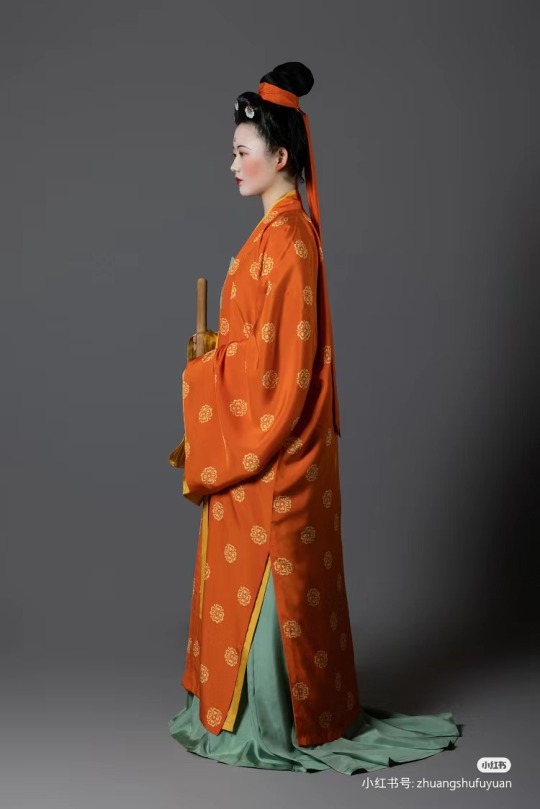
【Historical Reference Artifacts】:
Brick with portraits of people playing music and dancing unearthed from Feng Hui(冯辉)'s tomb,Bin County Cultural Collection, China.



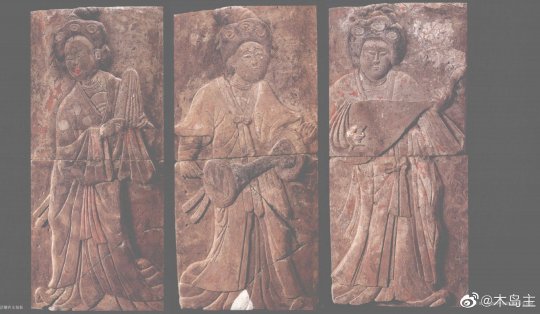
【China Five Dynasties & Ten Kingdoms Period Musician and Dancer Garment 】
During the Five Dynasties period, the development of costume art showed a trend like “hundred flowers bloom”
At that time, clothing styles were diverse and there were fewer restrictions and constraints, and bolder artistic exploration began. On the one hand, the development of fine arts and aesthetic theories during the Tang and Song Dynasties also injected vigorous vitality into the art of clothing; on the other hand, the skills passed down from previous generations gave clothing a richer and more diverse style.
These influences, inherited from previous dynasty, became an important part of the fashion at that time and gradually developed into a classic paradigm. Among them, the long-skirt style attire originated from the late Tang Dynasty is still widely popular and favored by women. When matching this type of shirt and skirt, they often wear their hair in a tall and unique bun, creating a taller and slender silhouette. This style was inherited from the late Tang Dynasty and incorporated into the new trends of the times, making it appear solemn and beautiful.
This garment refers to the brick carvings of Feng Hui's tomb and restores the image of musicians from the Five Dynasties and later Zhou Dynasties. Their hair is in a high bun, their temples are hugging their faces, their hair is tied at the top, and they are decorated with precious pearls. They wear blouses and long skirts, and appear to be light and swaying in their steps. They have the beauty of smart, pretty, harmonious and elegant rhythm.
#chinese hanfu#five dynasties and ten kingdoms period#late zhou dynasty#hanfu#hanfu history#hanfu accessories#Chinese fashion history#Chinese#chinese history#hanfu_challenge#chinese traditional clothing#china#chinese#Chinese hairstyles#漢服#汉服#中華風#chinese style#chinese art
265 notes
·
View notes
Text
also now that I think about it, why doesn't the period where the Song dynasty was being incredibly cringefail and kept getting clotheslined by the Khitans (Liao dynasty), the Jurchen (Jin dynasty), and the Mongols (Yuan dynasty) one after the other - i.e. multiple centuries of multiple competing dynasties all vying for power with no definitive winner - not have a name when Spring and Autumn/Warring States (multiple centuries of multiple competing states all vying for power with no definitive winner) the Northern and Southern dynasties (multiple centuries of multiple competing dynasties all vying for power with no definitive winner), and Five Dynasties and Ten Kingdoms (a ~century with multiple competing dynasties etc etc) do? is there a good reason or is it just the racism
#my rambles#like the liao/jin/yuan have a way better claim to the title of 'dynasty' than the idiots at idk later jin I'll say that much
2 notes
·
View notes
Text
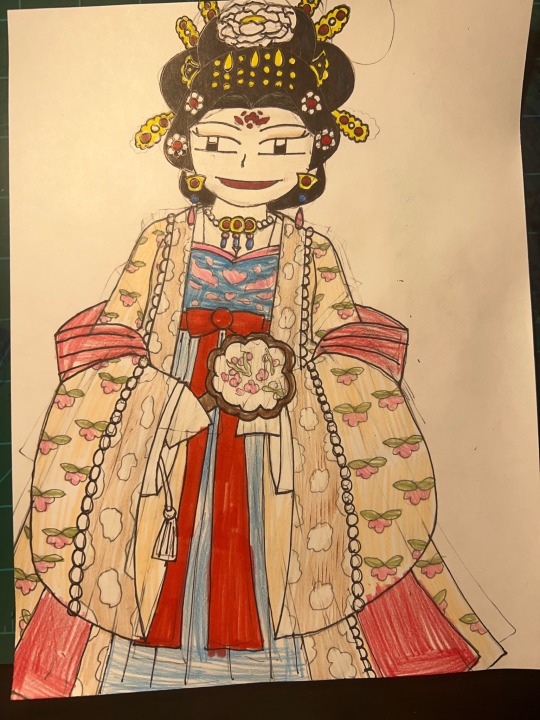
I drew a Chinese Consort from the Tang Dyansty. She is wearing a Daixiushan, a type of Hanfu worn by noble women from the late Tang Dynasty to five to ten kingdoms period. I hope you guys like it.
0 notes
Text
Five steps of Wikipedia for Sunday, 28th January 2024
Welcome, fáilte, welcome, ยินดีต้อนรับ (yin dee dtôn rab) 🤗
Five steps of Wikipedia from "Wu Guo Gushi" to "Alfred James Broomhall". 🪜👣

Start page 👣🏁: Wu Guo Gushi
"Wu Guo Gushi ("Stories of the Five States") is a 10th-century Song dynasty history book, which in 2 chapters describes 5 of the southern states during the chaotic Five Dynasties period (907–960): the Wu, Southern Tang, Later Shu (including information on Former Shu), Southern Han and Min Kingdom,..."
Step 1️⃣ 👣: Former Shu
"Great Shu (Chinese: 大蜀; pinyin: Dàshǔ), known in historiography as the Former Shu (Chinese: 前蜀; pinyin: Qiánshǔ) or occasionally Wang Shu (王蜀), was a dynastic state of China and one of the Ten Kingdoms during the Five Dynasties and Ten Kingdoms period. It existed from 907 to 925 CE. The country's..."

Image licensed under CC BY-SA 4.0? by Pavo Xie
Step 2️⃣ 👣: Ba–Shu culture
"Ba–Shu culture (Chinese: 巴蜀文化; pinyin: Bāshǔ wénhuà; Wade–Giles: Pa-Shu wên-hua), sometimes also named Chongqing–Sichuan culture, refers to the culture of Sichuan province and Chongqing city, China and the surrounding areas, including parts of the neighboring provinces of Yunnan and Guizhou, since..."
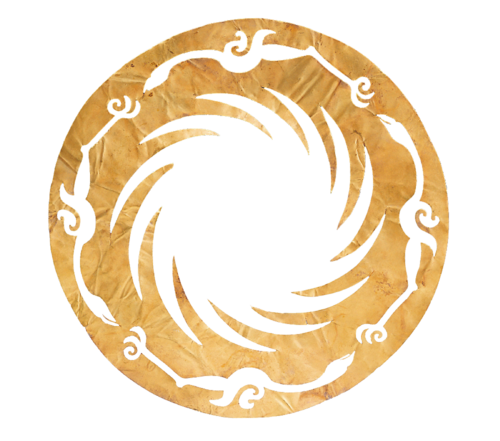
Image by Jinsha Site Museum. Original author: ancient Shu people.
Step 3️⃣ 👣: Bailu, Pengzhou
"Bailu (Chinese: 白鹿; pinyin: Báilù; lit. 'White Deer') is a town under the administration of Pengzhou, Sichuan, China. As of 2018, it has one residential community and eight villages under its administration...."

Image licensed under CC BY-SA 4.0? by Uriel1022
Step 4️⃣ 👣: Albert Shelton
"Albert Leroy Shelton (1875-1922) was an American medical doctor and a Protestant missionary in Tibet, especially in Batang in the Kham region of eastern Tibet, from 1903 until 1922. He authored a popular book about his experiences and collected Tibetan cultural items and sold them to museums. He was..."

Image by Albert L. Shelton
Step 5️⃣ 👣: Alfred James Broomhall
"Alfred James Broomhall (6 December 1911 – 11 May 1994), also known as Anthony James Broomhall, or A. J. Broomhall, was a British Baptist Christian medical missionary to China, and author and historian of the China Inland Mission (renamed as Overseas Missionary Fellowship in 1964, known today as OMF..."
0 notes
Text

Egyptian calendar arises at the beginning of 3rd Millennium BC and is the first known solar calendar in history.
It was in full use at the time of Shepseskaf, the pharaoh of the Fourth Dynasty.
In Pyramid Texts, the 365 days of the Egyptian civil year are mentioned. It was divided into 12 months of 30 days each, organized into three groups of ten.
At the end of the last month of each year, the five days (epagomena) that were left to complete the solar year were added — dedicated to various Egyptian gods.
“The Egyptians were the first of all men who discovered the year, and they said that they found this from the stars.” (Herodotus Histories II-4)
As Egyptian civil calendar did not have the fourth day that the astronomical solar year has in excess, every four years, it lost a day, so it became a “wandering calendar,” where “astronomically fixed periodic” events roamed through the months of calendar.
Since the dawn of the Empire, Egyptian priests carefully recorded the level of the waters, which they measured with nilometers.
Timing of sowing or harvesting depended on it, and after years of observations, they discovered that the cycle repeated every 365 days.
In Herodotus’s words: Egypt was a gift from the Nile.
This comment is not a literary image but a reality.
Annual river floods caused by the monsoon flooded the fields, covering the desert sands with fertile silt.
In Egypt, various calendars – Lunar, Solar (civil), and possibly a third secondary lunar calendar – were used to accurately calculate ephemeris.
Egyptian astronomical priests discovered that lunar calendars were not practical to predict the beginning of Nile floods, calculate the seasons, or count long periods, then comparing them with a measurement referring to the apparent movement of the Sun and the stars, they preferred to use the solar calendar for civil uses for the first time in history.
Egyptians may have used a lunar calendar before, but when they discovered the discrepancy between the lunar calendar and the regular passage of the seasons, they probably switched to a seasonal calendar, basing their regular onset on each annual Nile flood.
First flood according to The Calendar was observed in the first capital of Egypt, Memphis, at the same time as the heliacal rising of the star Sopdet (Sirius).
Egyptian year was divided into the three seasons of an agricultural nature:
• Flood (late summer and fall)
• Sowing (winter and early spring)
• Harvesting (late spring and early summer)
Astronomers in Middle Ages used Egyptian calendar because of its mathematical regularity.
Nicolaus Copernicus, for example, built his tables for the movement of planets based on measurement of time with Egyptian year.
Egyptian civil calendar had three seasons of four months of thirty days, plus five epagomenal days.
Only after the New Kingdom will the months of the civil calendar have their own names.
Name of months underwent variations over time, as well as the exact date of the beginning of the year.
The name given to each of the twelve months corresponds to the time of the New Kingdom.
Plus, five Heru-Renpet days (“those that are above the year” or epagomenal days), from August 24 to 28.
They were also known as (“of the birth of the gods”), since the birth of five Egyptian deities was celebrated in them: Osiris, Horus, Seth, Isis, and Nephthys.
Later, in the Coptic language , they were called Piabot Nkoyxi (“the little month”).
© Historical Eve
#Egyptian calendar#solar calendar#Shepseskaf#Ancient Egypt#ancient civilizations#Herodotus Histories#Nicolaus Copernicus#Piabot Nkoyxi#Egyptian deities#Egyptian priests
1 note
·
View note
Text
Universe of Kisuan pt.3/??
This is part one of who knows how many of posts about the world Atarah's Crown takes place in. This universe is called Kisuan, it's a collection of three (maybe more who knows) realms: Alius, Valideus, and Eohenia.
Today, we're gonna talk about the realm Valideus and yes I'm using my series/universe bible for this.
This one is a big boy...
Background:
Valideus was once apart of the realm Kisuan along with Alius and Eohenia, but split when the god Iohr was cast from the pantheon. Since then, the only magic applicable in the Valideus realm is a form of elemental magic or gifted by a deity.
There are ten countries which make up Valideus: Triuse, Condor, Saine, Huton, Osca, Norsia, Seyda, Budos, Domun, and Eal. The majority of the countries are specifically ran and controlled by a certain potestate, or elemental magic:
Triuse and Eal are Vitum
Codor, Saine, and Huton are Saxum
Norsia is Aura
Seyda is Ignis
Budos is Unda
Domun and Osca, the two great superpowers of Valideus, are a blend of the potestate.
This does not mean that these countries only have their respective potestates living there, only that they are the majorities.
Countries:

Yes I made that map, I'm very proud of it.
Domun
Eal
Triuse
Caldor
Saine
Hutton
Osca
Norsia
Seyda
History:
Age of Empires:
There was a great empire, Arcé. (In cannon era, this empire no longer exsists, though the capitol of Domun is named after it.)
The Arcean Empire stretched across present-day Domun, to Budos, Norsia, and Eal.
Effectively, Arcé was the largest empire the history of the Valideus Realm.
At the same time, the Empire of Caldu stretched from present-day Codor, through Siaine, all the way to Huton.
Lastly, there was the Innul Empire, reaching across Seyda and up to Norta.
During this period of history, Arcé and Caldu fought relentlessly with eachother, usually regarding borders.
Dark Ages:
Kisuan split into the three realms.
During this time, Caldu was the first empire to fall, leaving present day Caldor, Saine, and Hutton to be warring clans.
To the south, Arcé falls soon after, becoming five kingdoms who constantly fight with eachother aswell.
Only the Great Innul Empire remains standing without issue.
Middle Ages:
Provides a great upheaval in the political sphere of Valideus.
Socially, quet-gas (portals to other realms) are now being commonly used by the Datums to travel to Eohenia and Alius.
The Great Innul Empire fell, leaving the kingdoms of Norsia and Seyda in it’s wake.
Triuse now forms as a kingdown, opposit of the Vitus Mountains from Caldor.
This new knigdon stretches down through present day Domun–Umbra Terra–an Eal; effectively taking over Eal who was beginning to form as its own.
Budos spans across the modern-day Domunian territories of Idor, Monmor, and Eurus.
Lastly, modern-day Idor, Monmor, Eurus, Adrian, and Umbra Terra continues to war with one another.
Age of Enlightment and (Cannon) Age of Technology:
Unification of Domun.
Eal is left stranded from Triuse but is still a colony of Triuse.
Eventually, Eal gain independence and becomes its own nation.
There becomes a growing focus in learning potestates, especially for people who are not warriors.
Nobility, on the other hand, begins to stop learning and harnessing their potestates.
There is now more trade between Valideus and Alius, and Valideus and Eohenia; more people migrate and travel between the realms.
With this, we see a rise in social problems between the potestates, Datum, Cetari, and Venefi.
The Kalta Dynasty is established in Domun
Deities:
A single pantheon rules over Kisuan in its entirety and, so long as the pantheon remains complete, as will Kisuan. In the beginning, Kisuan was one realm, a combination of Alius, Valideus, and Eohenia, just as the pantheon was one. During the Dark Ages of Alius (the golden era for non-european countries) one god, Iohr, was cast out of the pantheon. In doing this, Kisuan was split into the three realms.
Deities In Valideus:
Goddess of Travelers and Peace: Asoi
Goddess of War and Strength: Coros
Magic:
The Valideus Realm is aport of the Kisuan Universe. While Alius does not have any forms of magic and Eohenia has “fantasy magic”, Valideus has potestates. Magic in the Valideus Realm comes in two faucets. Potestates, an elemental type magic, and Gifts, blessings from the Goddess Asoi. (I'll make a post specifically about potestates but here's a quick overview)
Potestates:
Potestates are passed down from parent to child. There is no dominant or recessive potestate, so it's pretty much a 50/50 chance if the parents have different ones.
Aura, the potestate of Air
Ignis, the potestates of Fire
Saxum, the potestate of Earth
Unda, the potestate of Water
Vitum, the potestate of Shadows
Gifts:
Gifts are abilities or a form of magic that fall outside of the scope of potestates. Datums and Semisos Datums can get them in a (for lack of a better descriptor) baptismal like ritual from the goddess, Asoi. Some beleive that the Gift you receive says something about either the life you will live or who you are. For example, here are the Gifts of the four main characters in the Atarah's Crown series:
Enayat Asen, Gift of Empathy (he can see people's emotions like colored auras)
Roman Eren, Gift of Endurance (he can push his body's limits past what he should be able to. Ie. running further distances without training, holding his breath for longer than should be possible, etc.)
Piper Caroll, Gift of Replication (she can create multiple mirror images of herself)
Iris Dunn, Gift of Healing (she can manipulate cell regeneration and heal cuts, bruises, broken bones, etc.)
#writeblr#writers on tumblr#writers#writing#ya writer#ya fantasy writer#ya fantasy#write#world building#wip world building#fantasy world building#kisuan#atarah's crown#alius realm#valideus realm#eohenia realm
0 notes